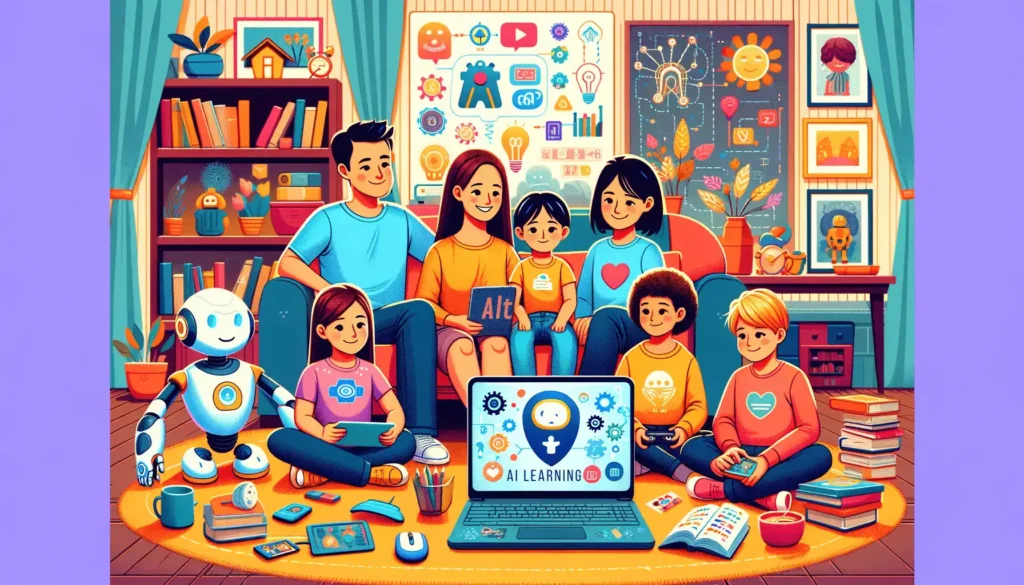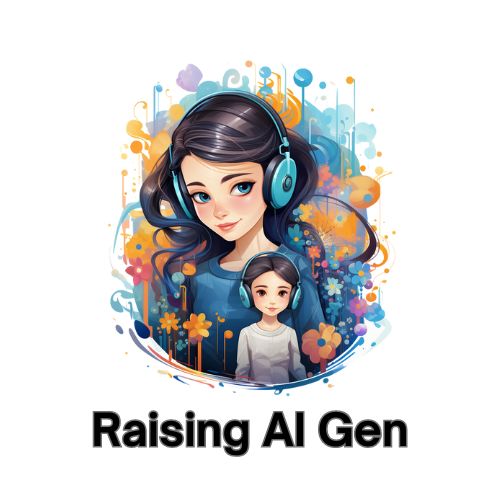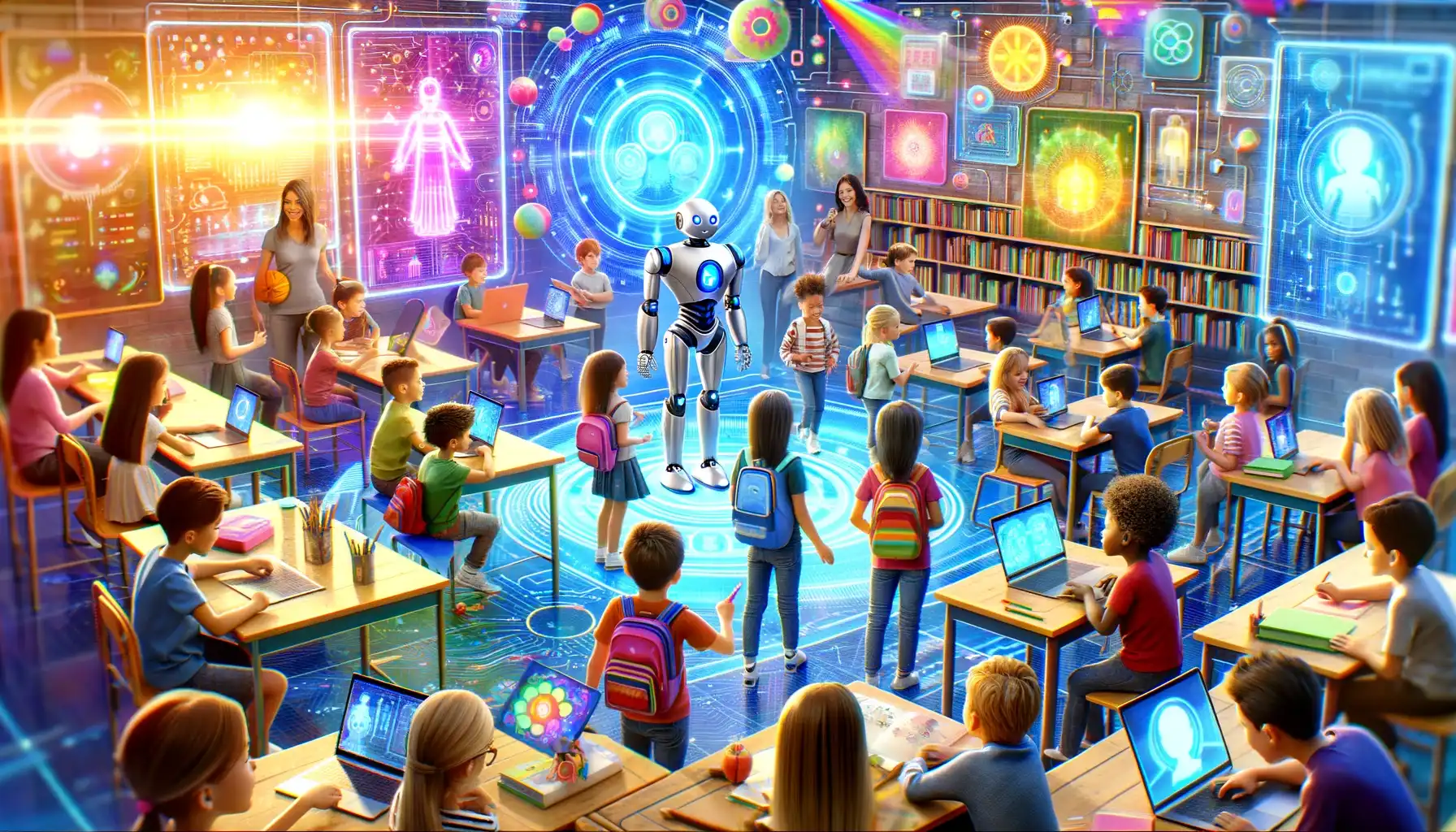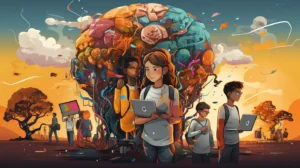Introducing AI to Children: In a world swiftly embracing digital transformations, the concept of Artificial Intelligence (AI) has moved from science fiction to everyday reality.
AI is not just a buzzword; it’s a rapidly evolving field shaping various aspects of our lives, from how we interact with smart devices at home to the way we approach problem-solving and innovation.
For today’s youth, understanding AI is not just fascinating—it’s essential.
Key Takeaways
- AI’s Growing Influence: AI’s role in modern technology and daily life.
- Early Education Benefits: The advantages of introducing AI concepts to children.
- Learning Made Fun: Engaging ways to teach AI to the younger generation.
- Parental Guidance: The crucial role parents play in AI education.
- Preparing for the Future: How AI knowledge equips children for future challenges.
The surge in AI’s prominence makes it crucial for the younger generation to grasp its basics. Not only does this knowledge prepare them for a tech-centric future, but it also nurtures critical thinking and adaptability—skills vital in any field.
Understanding AI: A Child’s Perspective
AI, or Artificial Intelligence, may sound like a complex and futuristic concept, but at its core, it’s about machines thinking and learning like humans.
The Basics of AI
At its simplest, AI is about creating smart machines capable of performing tasks that typically require human intelligence.
This includes things like:
- Problem-solving: Just like we solve puzzles, AI can find solutions to complex problems.
- Learning: AI systems can learn from data and improve over time, much like how we learn from experience.
AI in Everyday Life
You might not realize it, but AI is all around us.
Here are a few examples:
- Smartphones: From voice assistants like Siri to personalized recommendations on social media.
- Video Games: Ever noticed how game characters learn from your playing style? That’s AI at work.
- Education Tools: There are AI-powered apps that can help with homework or language learning.

Why It Matters
Understanding AI is not just about keeping up with technology. It’s about:
- Being Informed: Knowing how AI works helps you understand the world better.
- Career Preparation: Many future jobs will involve AI, so learning about it now is a smart move.
For those interested in seeing how AI blends into the home environment, take a look at our article on AI in Smart Homes for more insights.
The Right Age to Introduce AI to Children
When it comes to introducing AI to the younger generation, one of the most common questions is: “What is the right age to start?” The answer is not one-size-fits-all, but there are general guidelines that can help.
Age-Appropriate Introduction
Early Childhood (Ages 3-5)
- Simple Concepts: Introduce basic ideas like voice commands or robotic toys.
- Playful Learning: Use AI-powered educational games that promote basic problem-solving.
Middle Childhood (Ages 6-8)
- Enhanced Learning: Introduce more advanced AI concepts through interactive apps and games.
- Storytelling: Use AI as a tool in storytelling, showing how it can create stories or art.
Tweens and Early Teens (Ages 9-14)
- Deeper Understanding: Explore AI’s role in various technologies and its potential for future innovations.
- Hands-on Projects: Encourage participation in AI-based projects or coding classes.
Teenagers (Ages 15 and Up)
- Critical Engagement: Dive into ethical discussions about AI and its impact on society.
- Career Exploration: Introduce AI as a potential career path, highlighting its relevance in various industries.
Cognitive Development and AI
Understanding AI requires a certain level of cognitive maturity. As children grow, their ability to grasp complex concepts improves, making it easier for them to understand and engage with AI.
- Critical Thinking: Older children and teenagers can better understand the implications and potential of AI.
- Abstract Thinking: The ability to think abstractly allows for a deeper understanding of AI’s invisible mechanisms.
The journey of introducing AI to children should align with their cognitive and emotional development. By tailoring AI education to each age group, we can ensure that children not only learn effectively but also develop a healthy and informed relationship with technology.
For insights into how AI is integrated into education, especially in the STEM fields, check out our in-depth look at AI in STEM Education.
Methods of Introducing AI to Children
Introducing AI to children can be a rewarding journey, filled with creativity and exploration.
The key is to make learning about AI interactive and enjoyable, especially for school students who are just beginning to understand its potential.
Interactive AI Games and Apps
Engaging with AI through Play:
- Educational Games: There are numerous games designed to teach AI concepts in a fun, interactive way.
- AI-Powered Apps: Apps that use AI to personalize learning experiences or create interactive stories can be both educational and entertaining.
Benefits of Learning through Games:
- Hands-On Experience: Games provide a practical understanding of how AI works.
- Creativity and Problem-Solving: Interactive play enhances creative thinking and problem-solving skills.
Educational Programs and Workshops
Structured Learning Opportunities:
- Workshops and Camps: Various organizations offer workshops or summer camps focused on AI and technology.
- School Programs: Some schools have integrated AI education into their curriculum.
Building a Foundation:
- Collaborative Learning: Group projects and workshops encourage teamwork and communication skills.
- Expert Guidance: Access to professionals in the field can inspire and inform students.
Role of Schools in Teaching AI
Formal Education and AI:
- Curriculum Integration: Schools are increasingly including AI topics in subjects like computer science and technology.
- Resource Availability: Schools can provide resources and tools that may not be accessible at home.
Long-Term Benefits:
- Career Preparation: Understanding AI can open up future career opportunities in various fields.
- Global Perspective: Learning about AI helps students understand its global impact and potential.
The Role of Parents in AI Education
Parental involvement is crucial in guiding and supporting children’s learning about AI. Here are some ways parents can help:
- Encouragement: Encourage curiosity and provide opportunities for learning.
- Resource Provision: Help find and provide access to AI learning tools and resources.
- Guided Exploration: Explore AI concepts and applications together with your child.

By integrating AI learning into both formal education and home life, we can provide a well-rounded and thorough understanding of AI for children. This holistic approach ensures they are not only tech-savvy but also ethically and socially aware of the implications of AI.
Benefits of Early AI Education
Introducing AI to children, offers a plethora of benefits that extend beyond mere technological proficiency. Understanding AI at an early age equips children with a set of skills and knowledge that are increasingly crucial in our tech-driven world.
Cognitive and Developmental Advantages
Enhanced Problem-Solving Skills:
- Analytical Thinking: AI education fosters a deeper understanding of complex problems and logical reasoning.
- Creative Solutions: Learning about AI encourages innovative thinking and creativity in problem-solving.
Improved Technological Literacy:
- Understanding Emerging Technologies: Early exposure to AI helps children understand and adapt to new technologies.
- Digital Fluency: Being comfortable with AI and technology can give students an edge in various academic and career fields.
Preparing for a Future with AI
Career Readiness:
- Diverse Opportunities: Knowledge of AI opens doors to numerous career paths in technology, science, healthcare, and more.
- Competitive Edge: Understanding AI can set students apart in job markets increasingly reliant on tech skills.
Global Impact Awareness:
- Understanding Ethical Implications: Early AI education includes discussions on the ethical use of technology.
- Social Responsibility: Learning about AI prepares students to contribute positively to society as informed citizens.
Real-World Applications and Success Stories
Inspirational Examples:
- Young Innovators: Stories of children and teenagers who have used AI to create solutions or start initiatives.
- Global Impact: Examples of AI making a difference in areas like environmental conservation, healthcare, and education.
Introducing AI to children is about more than just teaching them about a technology; it’s about preparing them for a future where AI is ubiquitous and empowering them to be proactive, responsible members of a tech-centric society.
For further exploration into AI’s role in various fields, have a look at our article on AI in Medical Education.
Challenges and Considerations
While introducing AI to children, offers numerous benefits, it also comes with its own set of challenges and considerations. Addressing these effectively is key to ensuring a positive and constructive learning experience.
Ethical Aspects of AI
Understanding the Implications:
- Data Privacy: Teaching children about the importance of data privacy in the context of AI usage.
- Bias and Fairness: Discussing how AI can sometimes reflect human biases and the importance of developing fair AI systems.
Promoting Responsible Use:
- Ethical Development: Encouraging ethical thinking when developing or using AI technologies.
- Awareness of Consequences: Understanding the potential consequences of AI in various sectors, such as employment and privacy.
Ensuring Age-Appropriate Content
Tailoring the Learning Experience:
- Simplicity for Younger Children: Presenting AI concepts in a simple, understandable manner for younger audiences.
- Complexity for Older Students: Introducing more complex aspects of AI, like machine learning algorithms, to older students.
Preventing Misinformation:
- Accurate Information: Ensuring that the content is factual and up-to-date.
- Critical Thinking: Teaching students to critically evaluate AI news and developments.
The Digital Divide
Accessibility Challenges:
- Resource Availability: Addressing the lack of access to technology and AI learning resources for some students.
- Inclusivity in AI Education: Ensuring that AI education is inclusive and accessible to all, regardless of socio-economic background.
While introducing AI to children opens up a world of opportunity, it is essential to navigate the journey with awareness and responsibility. Addressing these challenges head-on prepares young learners not just to use AI, but to shape its development in a way that is ethical, fair, and beneficial for all.
Case Studies and Success Stories
Exploring real-world examples is a powerful way to illustrate the impact of AI education on children, who are curious about the practical applications of what they’re learning. These case studies and success stories serve as inspiration and proof of what’s achievable with AI knowledge.
Inspiring Young Minds Through AI
Individual Success Stories:
- Youth Innovators: Highlighting stories of young individuals who have used AI to solve problems or develop new tools.
- Global Competitions: Showcasing winners of youth AI competitions who have demonstrated exceptional skill and creativity.
Schools Leading the Way in AI Education:
- Innovative Programs: Schools that have successfully integrated AI into their curriculum and the impact on students.
- Collaborations with Tech Companies: Partnerships between educational institutions and tech companies to provide practical AI learning experiences.
Learning AI Beyond the Classroom
Community Initiatives:
- AI Workshops and Clubs: Community-based programs that offer AI education outside of the traditional school setting.
- Online Learning Platforms: Success stories of students who have utilized online resources to learn about AI.
Global Impact of AI Education
AI for Good:
- Environmental Solutions: Case studies of AI being used by young people to address environmental challenges.
- Healthcare Innovations: Examples of AI applications in healthcare developed by or for younger audiences.

These case studies not only demonstrate the practical applications of AI but also serve as a beacon, inspiring the next generation to explore and innovate in the field of AI.
For more in-depth exploration of AI in different sectors, consider reading our article on AI Chatbots for Mental Health, which discusses the innovative use of AI in healthcare.
Future of AI Education for Children
As we look toward the future, it’s clear that AI will continue to play a significant role in education and in the lives of children, who are at the cusp of their academic and professional journeys. Understanding the trends and predictions in AI education can help us prepare for what lies ahead.
Trends in AI Education
Increasing Accessibility:
- Wider Reach: Efforts are being made to make AI education accessible to a broader audience, regardless of geographical or socio-economic barriers.
- Online Learning Platforms: The rise of online platforms offers flexible, diverse AI learning opportunities.
Integration in Curricular Activities:
- School Programs: More schools are expected to integrate AI into their standard curriculum.
- Practical Applications: A focus on real-world applications of AI in classroom settings.
Predictions for AI in Education
Customized Learning Experiences:
- Personalized Education: AI could be used to tailor learning experiences to individual student needs and learning styles.
- Interactive Tools: Development of more sophisticated AI tools that make learning more engaging and effective.
Ethical and Social Implications:
- Ethics in AI Curriculum: An increased emphasis on teaching the ethical implications of AI.
- Global Perspective: Preparing students to understand and participate in discussions about AI on a global scale.
The future of AI education for children is bright and full of potential. It promises not just to educate but to revolutionize the way children learn and interact with the world around them.
Embracing the AI Revolution: Your Next Steps
As we draw our exploration of introducing AI to children to a close, it’s clear that the journey is just beginning. AI is not a distant future; it’s here, shaping our world and offering endless possibilities, especially for school students standing at the threshold of their future careers.
The key to unlocking these possibilities lies in education and awareness.
The Power of AI Knowledge
AI education is more than just a pathway to understanding technology; it’s a tool for empowerment, creativity, and innovation.
By introducing AI to children:
- We Equip Them for the Future: They gain skills that are essential in an increasingly AI-driven world.
- We Foster Creativity and Problem-Solving: AI challenges young minds to think differently and innovatively.
- We Prepare Responsible Digital Citizens: Understanding AI helps in developing a sense of responsibility towards technology and its impact on society.
Your Call to Action: Be a Part of the AI Movement
For Educators and Parents:
- Integrate AI Learning: Incorporate AI education into your teaching or parenting. Use resources like games, apps, and online platforms to make learning about AI accessible and fun.
- Promote Ethical Understanding: Engage in conversations about the ethical use of AI, highlighting its potential benefits and risks.
For Students:
- Explore and Learn: Dive into the world of AI. Participate in workshops, online courses, and competitions.
- Be Innovative: Think about how you can use AI to solve problems or create new opportunities.
For Everyone:
- Stay Informed: Keep up with the latest developments in AI. Understand its role in various sectors, from home security to healthcare, as seen in our articles on AI and Smart Home Security and AI Chatbots for Mental Health.
- Be Proactive: Don’t just be a spectator; be an active participant in the AI revolution.Frequently Asked Questions About Introducing AI to Children
Frequently Asked Questions
| Question | Answer |
|---|---|
| What is the best age to start teaching children about AI? | The right age can vary, but introducing simple AI concepts can begin as early as 3-5 years old, with more complex topics suitable for older children and teenagers. |
| How can AI education benefit my child? | AI education enhances problem-solving skills, boosts technological literacy, prepares children for future careers, and encourages them to think creatively and ethically about technology’s role in society. |
| Are there specific programs or tools for teaching AI to children? | Yes, there are numerous educational games, AI-powered apps, online platforms, and school programs that provide age-appropriate and engaging ways to learn about AI. |
| How can I, as a parent, support my child’s AI education? | Encourage their curiosity, provide them with learning resources, engage in AI-related discussions, and explore AI concepts together in a supportive environment. |
| What are some ethical considerations I should teach my child about AI? | Important topics include data privacy, the potential for AI bias, the ethical development and use of AI technologies, and the societal impact of AI. |
| Can learning about AI help my child in their future career? | Absolutely. AI knowledge is increasingly important in various fields, not just in technology but also in healthcare, environmental science, and more. |
| How can schools integrate AI education into their curriculum? | Schools can include AI topics in subjects like computer science, collaborate with tech companies for practical experiences, and provide resources for hands-on AI projects. |
| What should I do if my child shows a strong interest in AI? | Encourage them to participate in AI workshops, coding camps, online courses, and competitions. Help them find resources and communities where they can learn more and connect with like-minded peers. |
Further Reading
Here’s a table of “Further Reading” incorporating the internal links previously identified. This section will enhance the SEO of your article by providing additional resources for readers to explore:





